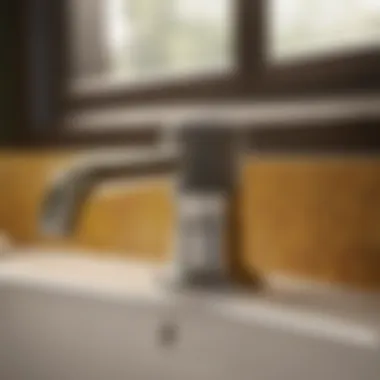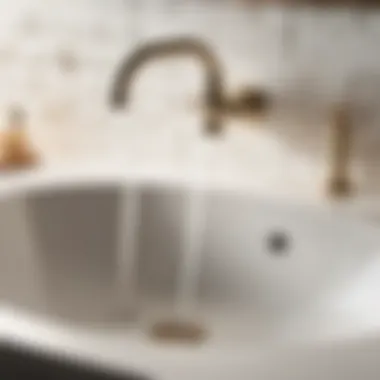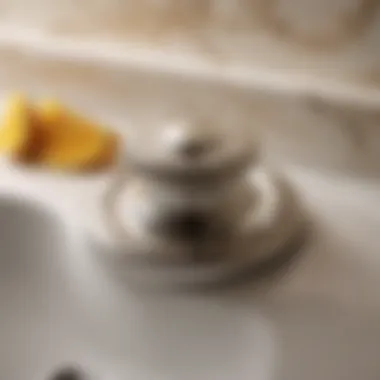Master the Art of Repairing a Bathroom Sink Stopper Like a Pro


Materials:
- Replacement sink stopper
- Adjustable wrench
- Pliers
- Plumber's putty
- Pipe wrench
- Bucket
- Towel
DIY Steps:
- Start by turning off the water supply: Locate the shut-off valves beneath the sink and turn them clockwise to stop the water flow.
- Remove the sink stopper: Unscrew the connecting rod nut underneath the sink and remove the pivot rod to release the stopper from the drain.
- Clean the area: Wipe down the drain area with a towel to remove any debris or old plumber's putty.
- Prepare the new stopper: Apply plumber's putty around the bottom edge of the replacement sink stopper.
- Install the new stopper: Place the stopper back into the drain and secure it in place by reattaching the pivot rod and connecting rod.
- Tighten the nuts: Use an adjustable wrench to tighten the connecting rod nut and ensure a secure fit.
- Test the stopper: Turn on the water supply and test the sink stopper by lifting and lowering it to check for smooth operation.
Technical Aspects:
- Tools: Ensure you have the necessary tools such as an adjustable wrench, pliers, and plumber's putty for a successful installation.
- Timing specifics: Allocate about 30-60 minutes to complete the sink stopper replacement, depending on your familiarity with plumbing tasks.
- Critical techniques: Properly applying plumber's putty and correctly aligning the pivot rod are crucial techniques for a leak-free and functional sink stopper.
DIY Project Process:
- Begin by disconnecting the old stopper carefully to avoid damaging the drain or surrounding pipes.
- Apply a sufficient amount of plumber's putty to create a watertight seal around the new stopper for optimal performance.
Troubleshooting Tips:
- If the sink stopper does not move smoothly, check the pivot rod alignment and adjust as needed.
- In case of leaks, ensure the connecting rod nut is securely fastened to prevent water seepage.
Introduction
In the realm of maintaining a functional and aesthetically pleasing bathroom, the sink stopper plays a crucial role that often goes unnoticed until issues arise. This article delves into the art of fixing a bathroom sink stopper, shedding light on commonly encountered problems and offering practical solutions that empower homeowners to take charge of their plumbing. Understanding the intricacies of sink stoppers not only ensures a smoother running household but can also save considerable time and money in the long run.
From dealing with stoppers that won't hold water to those stubbornly stuck in either open or closed positions, the knowledge and skills shared here will equip readers with the confidence to address such plumbing dilemmas effectively and efficiently. By delving into the nuances of sink stopper maintenance and repair, individuals can elevate their DIY plumbing prowess and enhance the functionality of their bathroom spaces. Stay tuned as we unravel the mysteries of sink stoppers, transcending them from pesky problems to manageable tasks that any homeowner can master.
Common Bathroom Sink Stopper Issues
In the realm of plumbing, facing common bathroom sink stopper issues is all too familiar for homeowners. Whether it's a sink stopper not holding water, being stuck closed, or even stuck open, these issues can disrupt daily routines. Understanding and addressing these problems promptly is crucial in maintaining a functional bathroom. By delving into the specifics of each issue, homeowners can equip themselves with the necessary knowledge to handle any sink stopper mishaps effectively.
Sink Stopper Not Holding Water
When a sink stopper fails to hold water, it can lead to inconvenience and frustration during everyday use. Two common approaches to resolving this issue include checking for debris and adjusting the stopper height.
Check for Debris
Checking for debris is a fundamental step in ensuring that the sink stopper functions as intended. Debris accumulation, such as hair or soap scum, can obstruct the stopper's mechanism, preventing it from creating a tight seal. By meticulously inspecting and removing any debris, homeowners can restore the stopper's functionality and prevent water leakage.
Adjust the Stopper Height
Adjusting the stopper height is another technique to address the issue of a sink stopper not holding water. By altering the stopper's positioning, homeowners can achieve the optimal fit to effectively contain water in the sink. This adjustment ensures that the stopper aligns perfectly with the drain, preventing any leaks and enabling smooth water retention.
Sink Stopper Stuck Closed


Encountering a sink stopper that is stuck closed can impede the flow of water down the drain, leading to potential blockages and drainage issues. Two main strategies for resolving this problem involve inspecting the pivot rod and lubricating moving parts.
Inspect the Pivot Rod
Inspecting the pivot rod is essential in understanding why the sink stopper is stuck closed. The pivot rod connects the stopper to the lift rod, allowing for the opening and closing of the stopper. Over time, debris or corrosion may interfere with the pivot rod's movement, causing the stopper to remain in the closed position. By thoroughly examining and addressing any issues with the pivot rod, homeowners can restore proper functionality to the sink stopper.
Lubricate Moving Parts
Lubricating the moving parts of the sink stopper mechanism is an effective way to resolve a stuck stopper. Applying lubricant to components such as the pivot rod and linkage can help facilitate smooth movement and prevent sticking. This maintenance measure reduces friction within the mechanism, ensuring that the stopper operates seamlessly.
Sink Stopper Stuck Open
On the other hand, a sink stopper stuck open can disrupt the sink's ability to hold water when needed. When faced with this issue, examining the stopper connection and considering replacing the stopper are recommended solutions.
Examine the Stopper Connection
Examining the stopper connection involves assessing the attachment of the stopper to the lift rod and drain mechanism. Loose or improperly connected stoppers can fail to seal the drain effectively, resulting in water drainage issues. By inspecting the stopper connection and securing it properly, homeowners can ensure that the stopper functions correctly.
Replace the Stopper
In cases where existing stoppers are damaged or beyond repair, replacing the stopper is a practical solution. New stoppers designed to fit the specific sink model can enhance functionality and provide a secure seal. By opting for a replacement stopper, homeowners can resolve the problem of a stuck open stopper and restore the sink's operational efficiency.
Tools and Materials Needed
When embarking on the journey of fixing a bathroom sink stopper, having the right tools and materials is paramount to the success of the task at hand. Without the appropriate equipment, even the most straightforward issues can become daunting. This section of the article will delve into the specific elements, benefits, and considerations related to the tools and materials required for this project.
Tools:
1. Adjustable Wrench:
An adjustable wrench is indispensable when it comes to loosening and tightening nuts and bolts. Its adaptability to various sizes makes it a versatile tool for plumbing tasks.
2. Screwdriver Set:
Different types of screws may hold the sink stopper mechanism in place. Having a set of screwdrivers with various heads will ensure you can engage with any screw type encountered during the process.
3. Pliers:
Whether it's removing a stuck pivot rod or holding small components in place, pliers are key in providing the necessary grip and leverage for intricate maneuvers during the repair.
4. Plumber's Putty:
Plumber's putty serves as a sealant when replacing parts, preventing leaks and ensuring a tight seal for the stopper mechanism. Its moldable nature makes it ideal for filling gaps and creating watertight seals.


Materials:
1. Replacement Parts:
In some cases, repairing a sink stopper may involve replacing certain components like the stopper itself, pivot rod, or washer. Having these replacements readily available can expedite the repair process.
2. Cleaning Solution:
To ensure proper functionality and hygiene, having a cleaning solution to sanitize the stopper mechanism and surrounding areas is essential. This will help remove grime and buildup, allowing for smoother operation.
3. Towels and Bucket:
Leaks and spills are inevitable during sink stopper repairs. Keeping towels and a bucket handy will aid in managing any water leakage and keeping the work area dry.
Importance:
The significance of the tools and materials needed for fixing a bathroom sink stopper cannot be overstated. Each item plays a vital role in completing the repair process effectively and efficiently. By having the right tools at your disposal, you not only ensure a smoother repair experience but also reduce the risk of causing further damage due to improvisation or using incorrect tools. Investing in quality tools and materials upfront can save both time and frustration in the long run.
Benefits:
Having a comprehensive set of tools and materials offers numerous benefits when it comes to repairing a bathroom sink stopper. It enhances precision and accuracy, reduces the chances of errors, and enables you to tackle a variety of issues that may arise during the repair process. Additionally, having all the necessary items readily available saves time and minimizes interruptions, allowing you to complete the repair efficiently.
Considerations:
Before beginning the repair, it's essential to ensure that you have all the required tools and materials on hand. Take inventory of the items needed and confirm their functionality and suitability for the task. Additionally, consider safety precautions when handling tools and materials, such as wearing protective gear and working in a well-ventilated area. Proper organization and preparation can streamline the repair process and contribute to a successful outcome.
Step-by-Step Guide to Fixing a Bathroom Sink Stopper
In this section, we will delve into the intricate process of fixing a bathroom sink stopper with a methodical approach. The step-by-step guide outlined here aims to equip readers with the necessary skills and knowledge to tackle this plumbing task efficiently and effectively. By following the detailed instructions provided, readers will be able to master the art of fixing a bathroom sink stopper with confidence.
Preparation
Gather Tools and Materials
When embarking on the journey of fixing a bathroom sink stopper, one of the critical aspects is gathering the essential tools and materials required for the task. These tools may include a wrench, pliers, screwdrivers, and a replacement stopper if needed. It is crucial to gather these items beforehand to ensure a smooth and seamless repair process. By having the right tools at your disposal, you can significantly streamline the repair process and avoid any unnecessary delays.
Turn Off Water Supply
Before initiating any repair work on the sink stopper, it is imperative to turn off the water supply to the sink. This step helps prevent any water leakage or accidents during the repair process. By shutting off the water supply valves, you ensure a safe working environment and minimize the risk of water damage. This precautionary measure sets the stage for a focused and uninterrupted repair session.
Removing the Stopper
Locate the Pivot Rod


The first step in removing the sink stopper involves locating the pivot rod beneath the sink. The pivot rod is a crucial component that connects the stopper to the lift rod behind the faucet. By identifying and locating the pivot rod, you pave the way for seamless removal of the stopper. This step sets the foundation for disassembling the stopper mechanism and addressing any underlying issues effectively.
Disconnect Stopper
After locating the pivot rod, the next step is to disconnect the stopper from the pivot rod. This process may involve unscrewing or unclipping the stopper from the pivot rod, depending on the type of stopper mechanism installed. By disconnecting the stopper carefully, you can proceed with the repair process and troubleshoot any obstacles preventing the stopper from functioning correctly.
Troubleshooting and Repair
Addressing Specific Issues
In this phase of the repair process, it is crucial to address any specific issues that may be affecting the sink stopper's functionality. Common issues include debris buildup, worn-out parts, or misalignments within the stopper mechanism. By identifying and addressing these specific issues, you can rectify the underlying problems and restore the stopper's optimal performance.
Replacing Damaged Parts
If troubleshooting reveals that certain parts of the sink stopper are damaged or worn out, it may be necessary to replace these components. Whether it's a deteriorated gasket, a broken linkage, or a faulty lever, replacing damaged parts is essential for ensuring the longevity and functionality of the sink stopper. By opting for high-quality replacement parts, you can enhance the overall performance of the stopper mechanism.
Reassembling the Stopper
Reconnect Pivot Rod
After addressing any underlying issues and replacing damaged parts, the final step is to reassemble the sink stopper. This involves reconnecting the pivot rod to the lift rod and ensuring proper alignment of the stopper mechanism. By reattaching the components securely and aligning them correctly, you can test the stopper's functionality and verify that the repair work has been successfully completed.
Test the Stopper
An essential part of the reassembly process is testing the stopper to confirm that it is functioning correctly. By operating the stopper mechanism and observing its response, you can determine whether the repair work has been effective. Testing the stopper ensures that water is drained smoothly, and the stopper operates as intended, providing a seal when needed. This final step validates the success of the repair and allows you to enjoy a fully functional sink stopper once more.
Maintenance Tips for a Healthy Sink Stopper
When it comes to maintaining a healthy sink stopper, preventive measures play a crucial role in ensuring the efficient functioning of your bathroom plumbing system. This section of the article will delve into the essential maintenance tips that will not only prolong the lifespan of your sink stopper but also prevent potential issues from arising, saving you time and money in the long run.
Importance of Maintenance Tips
Regular upkeep of your sink stopper is key to avoiding unexpected blockages, leaks, and malfunctions. By incorporating routine maintenance practices, you can prevent debris buildup, corrosion, and wear and tear on the stopper components, ultimately preserving the overall integrity of your sink drainage system.
Specific Elements to Consider
To maintain a healthy sink stopper, start by implementing simple yet effective measures such as regular cleaning to remove accumulated grime and hair that can obstruct the stopper's movement. Additionally, inspecting the linkage and moving parts for any signs of damage or deterioration is essential to address minor issues before they escalate into major repairs.
Benefits of Regular Maintenance
By dedicating time to maintain your sink stopper, you can enjoy benefits such as improved water flow, reduced likelihood of clogs, and a longer lifespan for your plumbing fixtures. Furthermore, a well-maintained sink stopper contributes to a hygienic bathroom environment by preventing mold and mildew growth, promoting a clean and refreshing space for everyday use.
Considerations for Effective Maintenance
Incorporate maintenance tasks into your monthly cleaning routine, such as using mild cleaning agents to dissolve residue and obstructions in the drain. Additionally, being mindful of what goes down the sink can prevent blockages and maintain the functionality of your stopper. Regular inspections and minor repairs as needed can save you from costly plumbing emergencies and ensure a smoothly running sink system.
Conclusion
In essence, the conclusion encapsulates the practicality and importance of acquiring the skills to address sink stopper issues promptly and effectively. By following the guidelines outlined in this article, readers can transform their approach to plumbing maintenance, setting a standard for a healthier and more efficient bathroom experience.







